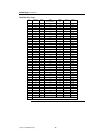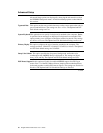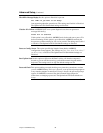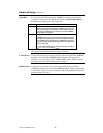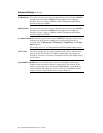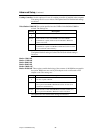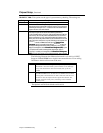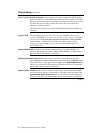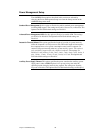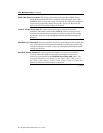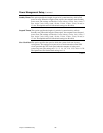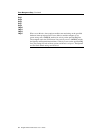
Chapter 2 WINBIOS Setup 57
Chipset Setup, Continued
DRAM ECC Mode This option sets the type of system memory checking. The settings are:
Setting Description
Disabled
No error checking or error reporting is done.
Level I
Multibit errors are detected and reported as parity errors. Single-bit errors are
corrected by the chipset. Corrected bits of data from memory are not written back
to DRAM system memory. If
Level I
is selected, the J27 External SMI software
jumper on the Series 735 board is disabled.
Level II
Multibit errors are detected and reported as parity errors. Single-bit errors are
corrected by the chipset and are written back to DRAM system memory.
If a soft (correctable) memory error occurs, writing the fixed data back to DRAM
system memory will resolve the problem. Most DRAM errors are soft errors. If a
hard (uncorrectable) error occurs, writing the fixed data back to DRAM system
memory does not solve the problem. In this case, the second time the error occurs
in the same location, a Parity Error is reported, indicating an uncorrectable error.
If
Level II
is selected, AMIBIOS automatically sets the Standard Power
Management option in Power Management Setup to
Enabled
to make sure
that the System Management Interface (SMI) is enabled. If you do not want to
enable power management, set the Advanced Power Management (APM) option
to
Disabled
and set all Power Management Setup timeout options to
Disabled.
To enable power management, set Advanced Power Management
(APM) to
Enabled
and set the power management timeout options as desired.
The following illustrates the difference between Level I and Level II ECC.
Suppose a DRAM SIMM has a single bit uncorrectable error. Even writing
fixed data to this bit will not remove the error.
Setting then...
Level I the data error is fixed during the memory read cycle every time
the bad bit is accessed and the system continues to run, although
every time the bad bit is read and corrected, CPU cycles are
wasted.
Level II the system tries to write the corrected data back to the bad bit in
the DRAM SIMM. Since the bad bit in the SIMM cannot be fixed,
writing data to the bad bit has no effect. The next time the error
location is read, the chipset will once again find a bad bit. The
chipset generates a Parity Error, indicating an uncorrectable
memory error.
The Optimal and Fail-Safe defaults are Disabled.
Cont’d



